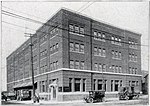Saint Patrick Church (Columbus, Ohio)
19th-century Roman Catholic church buildings in the United StatesBuildings and structures in Downtown Columbus, OhioDominican churches in the United StatesGothic Revival architecture in OhioRoman Catholic churches completed in 1853 ... and 1 more
Roman Catholic churches in Columbus, Ohio

Saint Patrick Church is a historic building and the second-oldest Catholic church building in Columbus, Ohio. Located in the Discovery District neighborhood, the structure served as the pro-cathedral of the Roman Catholic Diocese of Columbus until the consecration of Saint Joseph Cathedral. It has been served by priests of the Dominican Order since 1885 and is currently home to an active parish.
Excerpt from the Wikipedia article Saint Patrick Church (Columbus, Ohio) (License: CC BY-SA 3.0, Authors, Images).Saint Patrick Church (Columbus, Ohio)
North Kelly Alley, Columbus
Geographical coordinates (GPS) Address Nearby Places Show on map
Geographical coordinates (GPS)
| Latitude | Longitude |
|---|---|
| N 39.969016 ° | E -82.991732 ° |
Address
Saint Patricks School
North Kelly Alley
43215 Columbus
Ohio, United States
Open on Google Maps









